Ya Wang
VGR: Visual Grounded Reasoning
Jun 16, 2025Abstract:In the field of multimodal chain-of-thought (CoT) reasoning, existing approaches predominantly rely on reasoning on pure language space, which inherently suffers from language bias and is largely confined to math or science domains. This narrow focus limits their ability to handle complex visual reasoning tasks that demand comprehensive understanding of image details. To address these limitations, this paper introduces VGR, a novel reasoning multimodal large language model (MLLM) with enhanced fine-grained visual perception capabilities. Unlike traditional MLLMs that answer the question or reasoning solely on the language space, our VGR first detects relevant regions that may help to solve problems, and then provides precise answers based on replayed image regions. To achieve this, we conduct a large-scale SFT dataset called VGR -SFT that contains reasoning data with mixed vision grounding and language deduction. The inference pipeline of VGR allows the model to choose bounding boxes for visual reference and a replay stage is introduced to integrates the corresponding regions into the reasoning process, enhancing multimodel comprehension. Experiments on the LLaVA-NeXT-7B baseline show that VGR achieves superior performance on multi-modal benchmarks requiring comprehensive image detail understanding. Compared to the baseline, VGR uses only 30\% of the image token count while delivering scores of +4.1 on MMStar, +7.1 on AI2D, and a +12.9 improvement on ChartQA.
Visual Perturbation and Adaptive Hard Negative Contrastive Learning for Compositional Reasoning in Vision-Language Models
May 21, 2025Abstract:Vision-Language Models (VLMs) are essential for multimodal tasks, especially compositional reasoning (CR) tasks, which require distinguishing fine-grained semantic differences between visual and textual embeddings. However, existing methods primarily fine-tune the model by generating text-based hard negative samples, neglecting the importance of image-based negative samples, which results in insufficient training of the visual encoder and ultimately impacts the overall performance of the model. Moreover, negative samples are typically treated uniformly, without considering their difficulty levels, and the alignment of positive samples is insufficient, which leads to challenges in aligning difficult sample pairs. To address these issues, we propose Adaptive Hard Negative Perturbation Learning (AHNPL). AHNPL translates text-based hard negatives into the visual domain to generate semantically disturbed image-based negatives for training the model, thereby enhancing its overall performance. AHNPL also introduces a contrastive learning approach using a multimodal hard negative loss to improve the model's discrimination of hard negatives within each modality and a dynamic margin loss that adjusts the contrastive margin according to sample difficulty to enhance the distinction of challenging sample pairs. Experiments on three public datasets demonstrate that our method effectively boosts VLMs' performance on complex CR tasks. The source code is available at https://github.com/nynu-BDAI/AHNPL.
Efficient Pretraining Length Scaling
Apr 21, 2025Abstract:Recent advances in large language models have demonstrated the effectiveness of length scaling during post-training, yet its potential in pre-training remains underexplored. We present the Parallel Hidden Decoding Transformer (\textit{PHD}-Transformer), a novel framework that enables efficient length scaling during pre-training while maintaining inference efficiency. \textit{PHD}-Transformer achieves this through an innovative KV cache management strategy that distinguishes between original tokens and hidden decoding tokens. By retaining only the KV cache of original tokens for long-range dependencies while immediately discarding hidden decoding tokens after use, our approach maintains the same KV cache size as the vanilla transformer while enabling effective length scaling. To further enhance performance, we introduce two optimized variants: \textit{PHD-SWA} employs sliding window attention to preserve local dependencies, while \textit{PHD-CSWA} implements chunk-wise sliding window attention to eliminate linear growth in pre-filling time. Extensive experiments demonstrate consistent improvements across multiple benchmarks.
HybridNorm: Towards Stable and Efficient Transformer Training via Hybrid Normalization
Mar 06, 2025Abstract:Transformers have become the de facto architecture for a wide range of machine learning tasks, particularly in large language models (LLMs). Despite their remarkable performance, challenges remain in training deep transformer networks, especially regarding the location of layer normalization. While Pre-Norm structures facilitate easier training due to their more prominent identity path, they often yield suboptimal performance compared to Post-Norm. In this paper, we propose $\textbf{HybridNorm}$, a straightforward yet effective hybrid normalization strategy that integrates the advantages of both Pre-Norm and Post-Norm approaches. Specifically, HybridNorm employs QKV normalization within the attention mechanism and Post-Norm in the feed-forward network (FFN) of each transformer block. This design not only stabilizes training but also enhances performance, particularly in the context of LLMs. Comprehensive experiments in both dense and sparse architectures show that HybridNorm consistently outperforms both Pre-Norm and Post-Norm approaches, achieving state-of-the-art results across various benchmarks. These findings highlight the potential of HybridNorm as a more stable and effective technique for improving the training and performance of deep transformer models. %Code will be made publicly available. Code is available at https://github.com/BryceZhuo/HybridNorm.
FwNet-ECA: Facilitating Window Attention with Global Receptive Fields through Fourier Filtering Operations
Feb 25, 2025Abstract:Windowed attention mechanisms were introduced to mitigate the issue of excessive computation inherent in global attention mechanisms. However, In this paper, we present FwNet-ECA, a novel method that utilizes Fourier transforms paired with learnable weight matrices to enhance the spectral features of images. This strategy facilitates inter-window connectivity, thereby maximizing the receptive field. Additionally, we incorporate the Efficient Channel Attention (ECA) module to improve communication between different channels. Instead of relying on physically shifted windows, our approach leverages frequency domain enhancement to implicitly bridge information across spatial regions. We validate our model on the iCartoonFace dataset and conduct downstream tasks on ImageNet, demonstrating that our model achieves lower parameter counts and computational overheads compared to shifted window approaches, while maintaining competitive accuracy. This work offers a more efficient and effective alternative for leveraging attention mechanisms in visual processing tasks, alleviating the challenges associated with windowed attention models. Code is available at https://github.com/qingxiaoli/FwNet-ECA.
Scale-Distribution Decoupling: Enabling Stable and Effective Training of Large Language Models
Feb 21, 2025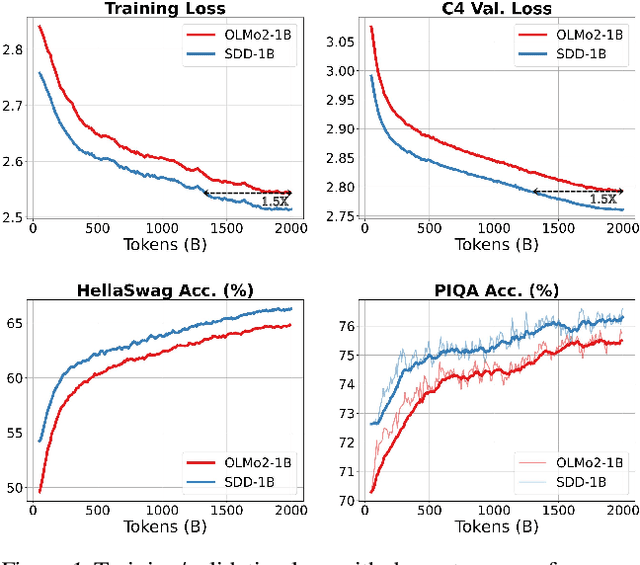
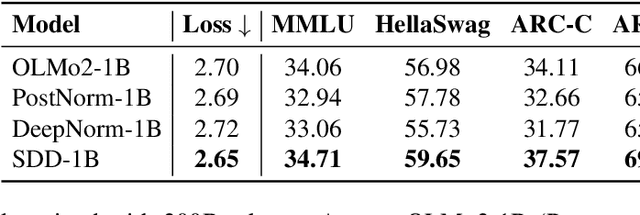
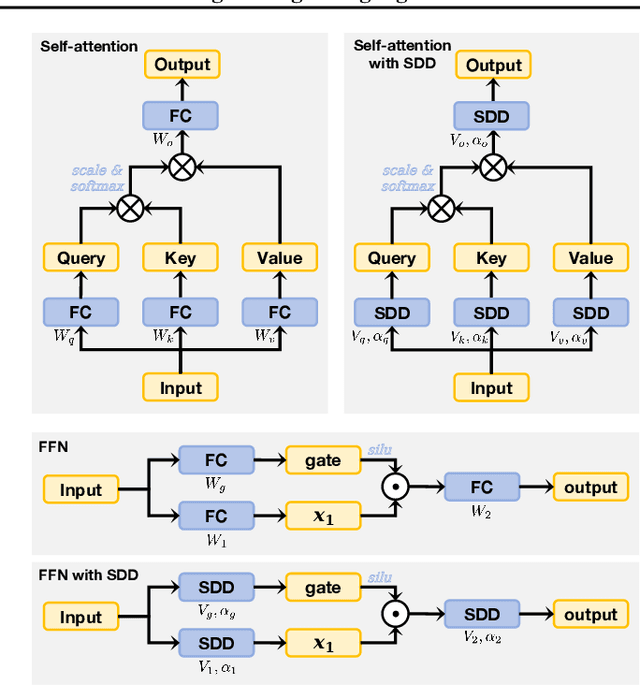
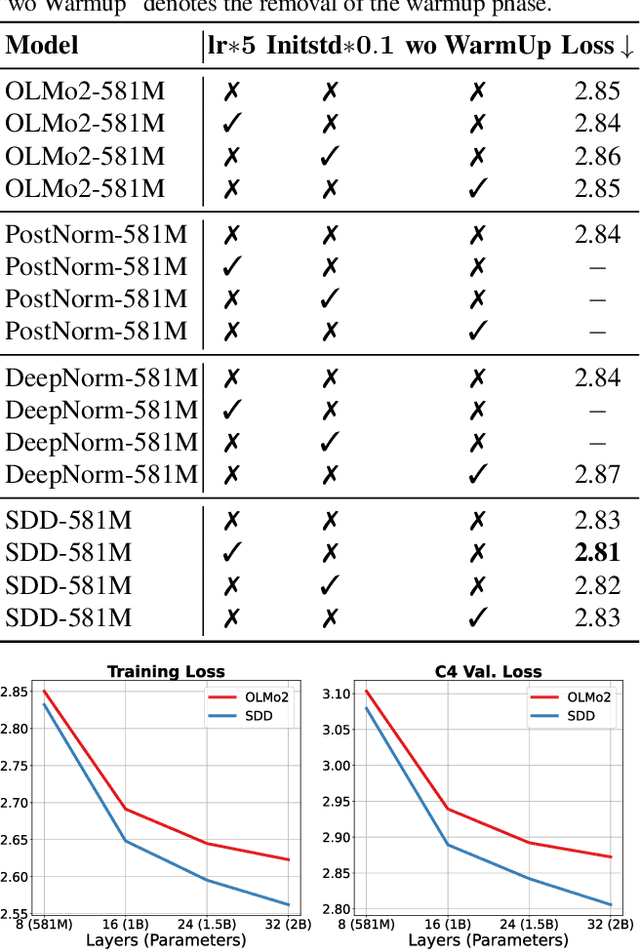
Abstract:Training stability is a persistent challenge in the pre-training of large language models (LLMs), particularly for architectures such as Post-Norm Transformers, which are prone to gradient explosion and dissipation. In this paper, we propose Scale-Distribution Decoupling (SDD), a novel approach that stabilizes training by explicitly decoupling the scale and distribution of the weight matrix in fully-connected layers. SDD applies a normalization mechanism to regulate activations and a learnable scaling vector to maintain well-conditioned gradients, effectively preventing $\textbf{gradient explosion and dissipation}$. This separation improves optimization efficiency, particularly in deep networks, by ensuring stable gradient propagation. Experimental results demonstrate that our method stabilizes training across various LLM architectures and outperforms existing techniques in different normalization configurations. Furthermore, the proposed method is lightweight and compatible with existing frameworks, making it a practical solution for stabilizing LLM training. Code is available at https://github.com/kaihemo/SDD.
Over-Tokenized Transformer: Vocabulary is Generally Worth Scaling
Jan 28, 2025Abstract:Tokenization is a fundamental component of large language models (LLMs), yet its influence on model scaling and performance is not fully explored. In this paper, we introduce Over-Tokenized Transformers, a novel framework that decouples input and output vocabularies to improve language modeling performance. Specifically, our approach scales up input vocabularies to leverage multi-gram tokens. Through extensive experiments, we uncover a log-linear relationship between input vocabulary size and training loss, demonstrating that larger input vocabularies consistently enhance model performance, regardless of model size. Using a large input vocabulary, we achieve performance comparable to double-sized baselines with no additional cost. Our findings highlight the importance of tokenization in scaling laws and provide practical insight for tokenizer design, paving the way for more efficient and powerful LLMs.
Explainable Fuzzy Neural Network with Multi-Fidelity Reinforcement Learning for Micro-Architecture Design Space Exploration
Dec 14, 2024Abstract:With the continuous advancement of processors, modern micro-architecture designs have become increasingly complex. The vast design space presents significant challenges for human designers, making design space exploration (DSE) algorithms a significant tool for $\mu$-arch design. In recent years, efforts have been made in the development of DSE algorithms, and promising results have been achieved. However, the existing DSE algorithms, e.g., Bayesian Optimization and ensemble learning, suffer from poor interpretability, hindering designers' understanding of the decision-making process. To address this limitation, we propose utilizing Fuzzy Neural Networks to induce and summarize knowledge and insights from the DSE process, enhancing interpretability and controllability. Furthermore, to improve efficiency, we introduce a multi-fidelity reinforcement learning approach, which primarily conducts exploration using cheap but less precise data, thereby substantially diminishing the reliance on costly data. Experimental results show that our method achieves excellent results with a very limited sample budget and successfully surpasses the current state-of-the-art. Our DSE framework is open-sourced and available at https://github.com/fanhanwei/FNN\_MFRL\_ArchDSE/\ .
Two-way Node Popularity Model for Directed and Bipartite Networks
Dec 11, 2024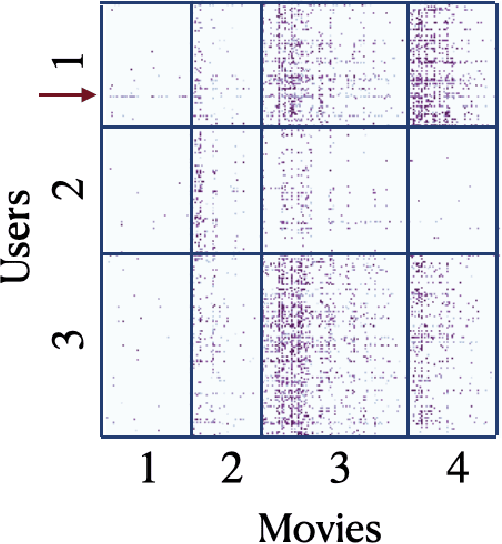
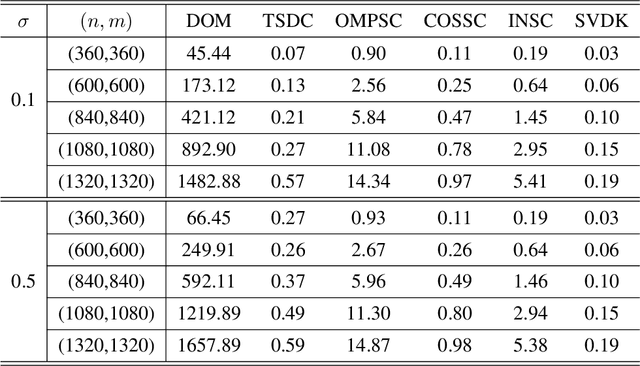
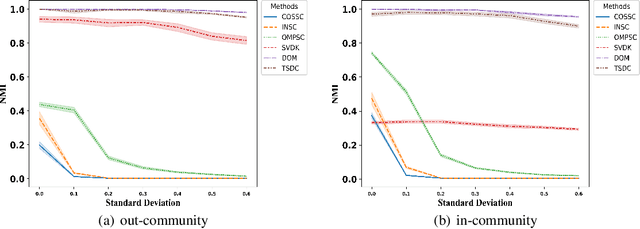
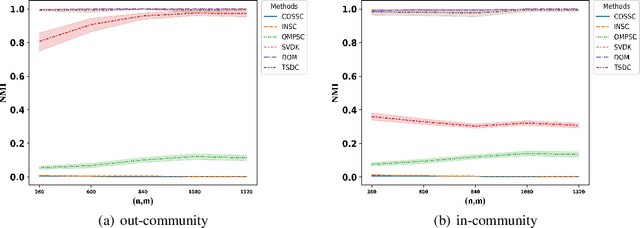
Abstract:There has been extensive research on community detection in directed and bipartite networks. However, these studies often fail to consider the popularity of nodes in different communities, which is a common phenomenon in real-world networks. To address this issue, we propose a new probabilistic framework called the Two-Way Node Popularity Model (TNPM). The TNPM also accommodates edges from different distributions within a general sub-Gaussian family. We introduce the Delete-One-Method (DOM) for model fitting and community structure identification, and provide a comprehensive theoretical analysis with novel technical skills dealing with sub-Gaussian generalization. Additionally, we propose the Two-Stage Divided Cosine Algorithm (TSDC) to handle large-scale networks more efficiently. Our proposed methods offer multi-folded advantages in terms of estimation accuracy and computational efficiency, as demonstrated through extensive numerical studies. We apply our methods to two real-world applications, uncovering interesting findings.
Polynomial Composition Activations: Unleashing the Dynamics of Large Language Models
Nov 06, 2024


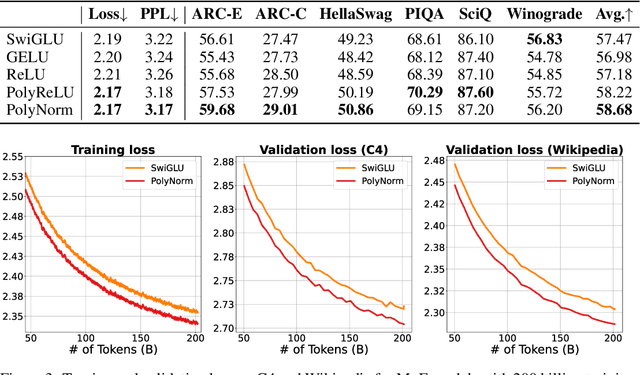
Abstract:Transformers have found extensive applications across various domains due to the powerful fitting capabilities. This success can be partially attributed to their inherent nonlinearity. Thus, in addition to the ReLU function employed in the original transformer architecture, researchers have explored alternative modules such as GeLU and SwishGLU to enhance nonlinearity and thereby augment representational capacity. In this paper, we propose a novel category of polynomial composition activations (PolyCom), designed to optimize the dynamics of transformers. Theoretically, we provide a comprehensive mathematical analysis of PolyCom, highlighting its enhanced expressivity and efficacy relative to other activation functions. Notably, we demonstrate that networks incorporating PolyCom achieve the $\textbf{optimal approximation rate}$, indicating that PolyCom networks require minimal parameters to approximate general smooth functions in Sobolev spaces. We conduct empirical experiments on the pre-training configurations of large language models (LLMs), including both dense and sparse architectures. By substituting conventional activation functions with PolyCom, we enable LLMs to capture higher-order interactions within the data, thus improving performance metrics in terms of accuracy and convergence rates. Extensive experimental results demonstrate the effectiveness of our method, showing substantial improvements over other activation functions. Code is available at https://github.com/BryceZhuo/PolyCom.
 Add to Chrome
Add to Chrome Add to Firefox
Add to Firefox Add to Edge
Add to Edge